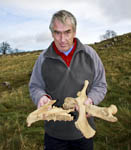 Experts want your help to try to solve a macabre mystery in the Yorkshire Dales.
Experts want your help to try to solve a macabre mystery in the Yorkshire Dales.
Archaeologists working in the south of the national park have found gruesome remains in the ruins of old limekilns – and they are baffled by the discoveries.
Ingleborough Archaeology Group chairman David Johnson with some of the bones
John Asher
Horses’ bones were found at Feizor and Newby Cote, near Clapham. The remains were found in kilns which had been abandoned and filled in. A horse skull was found in a kiln at Kilnsey in upper Wharfedale. Theories advanced by the teams involved include the possibility of the skulls and bones being placed to ward off evil spirits.
Members of the Ingleborough Archaeology Group, which excavated the sites, are also puzzled by the fact that quicklime was left in some of the kilns when it would have been expected to be put to use on nearby fields.
Chairman David Johnson said: “These were not animals that fell in or were thrown in.
“In two of the kilns, at Feizor and at Newby Cote, we found nearly identical sets of bones: a skull, at least one large leg bone, one shoulder bone and a couple of vertebrae. And they had all been stacked in a pile very neatly. One near Kilnsey just had a horse’s skull in it.
“There are many accounts of animals and other items being buried in the foundations of buildings while they were being constructed, but I have never found any examples of this happening as a closure ritual – this seems to be unique to these kilns.
“Perhaps the lime burners had been using them for many years and getting a good living out of them and then, for whatever reason, they closed the kilns and thought they should leave something behind to ward off any evil spirits that they may have imagined in their superstitious minds.
“I have contacted the English and Irish folklore societies and to Romany gypsies at the Appleby Horse Fair in Cumbria to see if any of them have heard of this practice but they haven’t.”
Robert White, senior conservation archaeologist with the Yorkshire Dales National Park Authority, appealed for anyone who had come across similar activity or had a plausible explanation for the burials to get in touch with him.
He said the kilns were all in use between about 1620 and 1670. Quicklime produced from burning local limestone was used to lessen the acidity of soil in fields and to increase its fertility. He added: “It’s not unusual for there to be primitive ritual activity in that period. If you think about it, even in the 20th century, rabbits’ feet and horseshoes were still being used as symbols of good luck.
“But why these particular bones were being buried in a kiln that was being backfilled after use is something else.”
If you can help the Yorkshire archaeologists in their quest for an explanation, contact us here at editor@grough.co.uk and we’ll put you in touch.